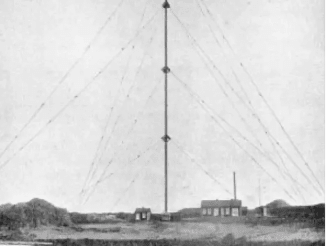Machrihanish Radio Station was established on the seafront at Uisaed Point, west of Machrihanish on the Kintyre Peninsula, in December 1905. It remained there as part of an experimental transatlantic radio system until December 1906, when it collapsed during a gale.
For Reginald Aubrey Fessenden, it was the transmission of speech and not the ‘dots and dashes’ of morse code which spurred him to greater effort. Toiling day and night, he cut almost microscopic incisions into a phonograph cylinder in order that his interrupter would break the circuit 10,000 times each second.
At the first trials voice sounds were unintelligible, but after persistent effort Fessenden was rewarded by performing the first miracle of transmitting the human voice without wires even though it was over the short distance of one mile in 1900 - five years before his transatlantic success.
The earliest references to the station appear to be in the Argyll Herald of May 1905, which reported that negotiations were underway for the lease of a field on which a wireless station was to be built. The venture was backed by the National Electric Signalling Company of Washington (NESCO), USA, and was paired with a similar project being undertaken at Brant Rock, Massachusetts, by the Canadian inventor, Reginald Aubrey Fessenden. The work was completed by December 1905, and the Campbeltown Courier carried an account of the structure:
The station stands about 450 feet high, being 50 feet higher than at first estimated. It looks like a badly proportioned chimneystack, having a cap-like arrangement on top all bristling with huge spikes. The whole ground within the boundaries is covered with a network of wires, laid grid fashion in trenches and covered only with some earth, and the ends of the wire are led into a deep trench along the shore at sea level. There are a few houses for the accommodation of the staff. The secrets of the station are being well preserved. The ground is fenced off and no visitors are allowed within the enclosure. Campbeltown Courier © 1905.
The mast was wide enough to incorporate a ladder within its interior, accessed by hatches at the base of each section, which allowed engineers to climb to the top, and carry out various tasks. At the base of the mast, a large metal ball was fixed to an insulated base, permitting the mast to rotate and avoid the creation of unnecessary stresses and bending along its length. The actual base construction, and method of insulating the mast at Machrihanish from the ground are unknown, and insufficient remains survive to identify these, however, the American base is known to have used layered stacks of ceramic insulators as used at the top of telephone poles, to keep the cost down. Next to the base was a small building with a chimney, which housed the station, equipment, and steam generator used to power it.


